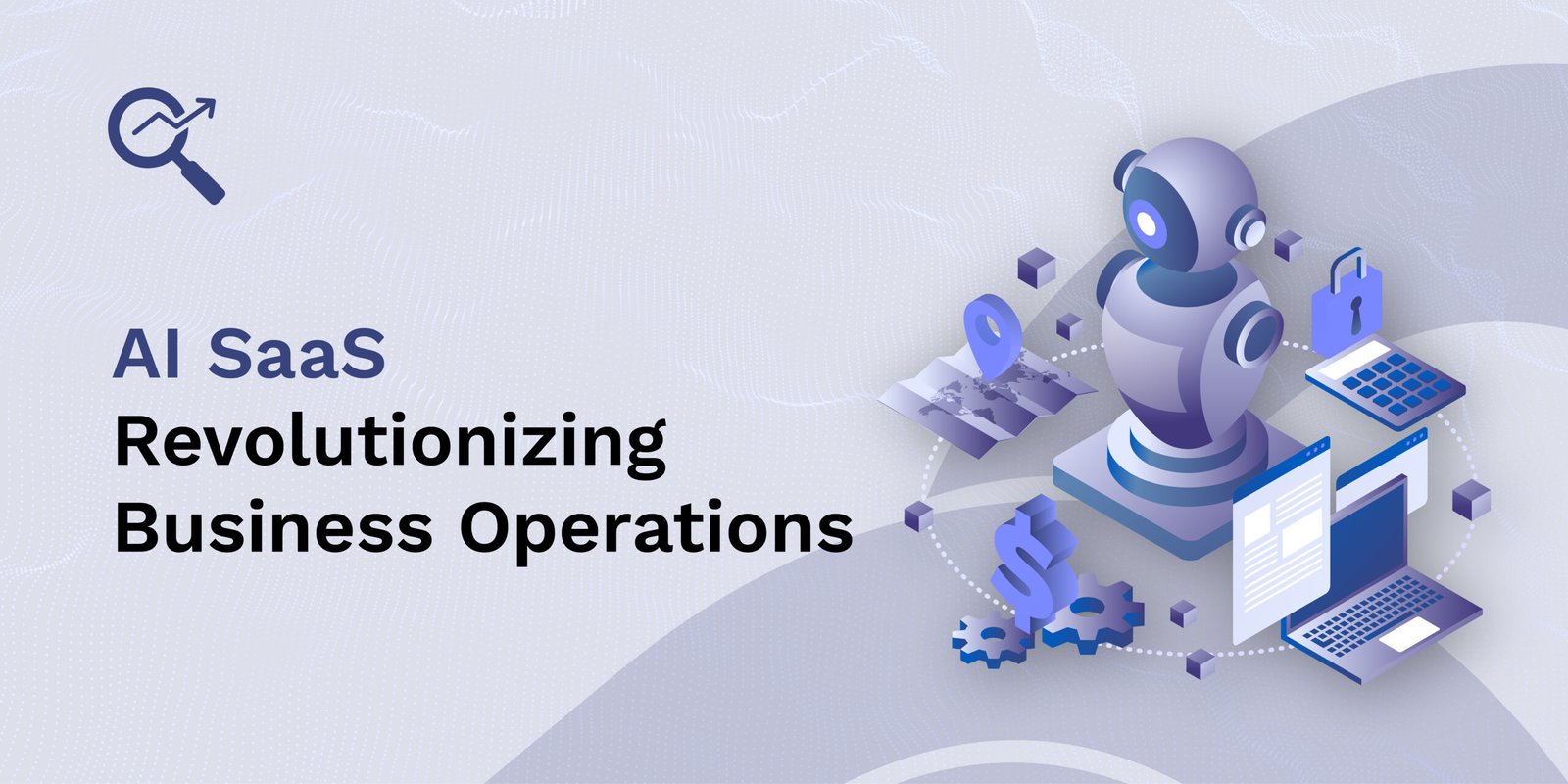We’re living in a time where artificial intelligence (AI) is no longer just a buzzword—it’s a business essential. And when you combine it with the flexibility and scalability of Software as a Service (SaaS), you get a powerful solution that’s transforming how companies operate, innovate, and grow.
If you’ve been wondering what AI SaaS really means or why it’s getting so much attention lately, you’re not alone. Whether you’re a tech enthusiast, a startup founder, or a decision-maker in a mid-size enterprise, understanding how artificial intelligence SaaS works (and why it matters) is the first step toward staying ahead in today’s digital economy.
Why It is Gaining Traction Across Industries?
- Cost-Effective: No need for huge upfront investments—just pay for what you use.
- Scalable: Instantly upgrade or downgrade based on your current business needs.
- Easy Integration: Seamlessly plugs into your existing tools and workflows.
- Data-Driven Decisions: AI insights help you act fast, reduce guesswork, and boost performance.
Think of AI SaaS as your behind-the-scenes partner—an intelligent system that works 24/7 to make your business smarter, leaner, and more responsive. And the best part? It’s accessible even to small teams that don’t have million-dollar tech budgets.
In the next sections, we’ll break down how AI SaaS works, real-life use cases, emerging trends, and how you can start using it today to gain a competitive edge.
What Is AI SaaS and Why It Matters?
Now that we’ve introduced the buzz around AI SaaS, let’s break it down so you can really understand what’s behind the term—and why it’s changing the game for businesses of all sizes.
What is AI SaaS?
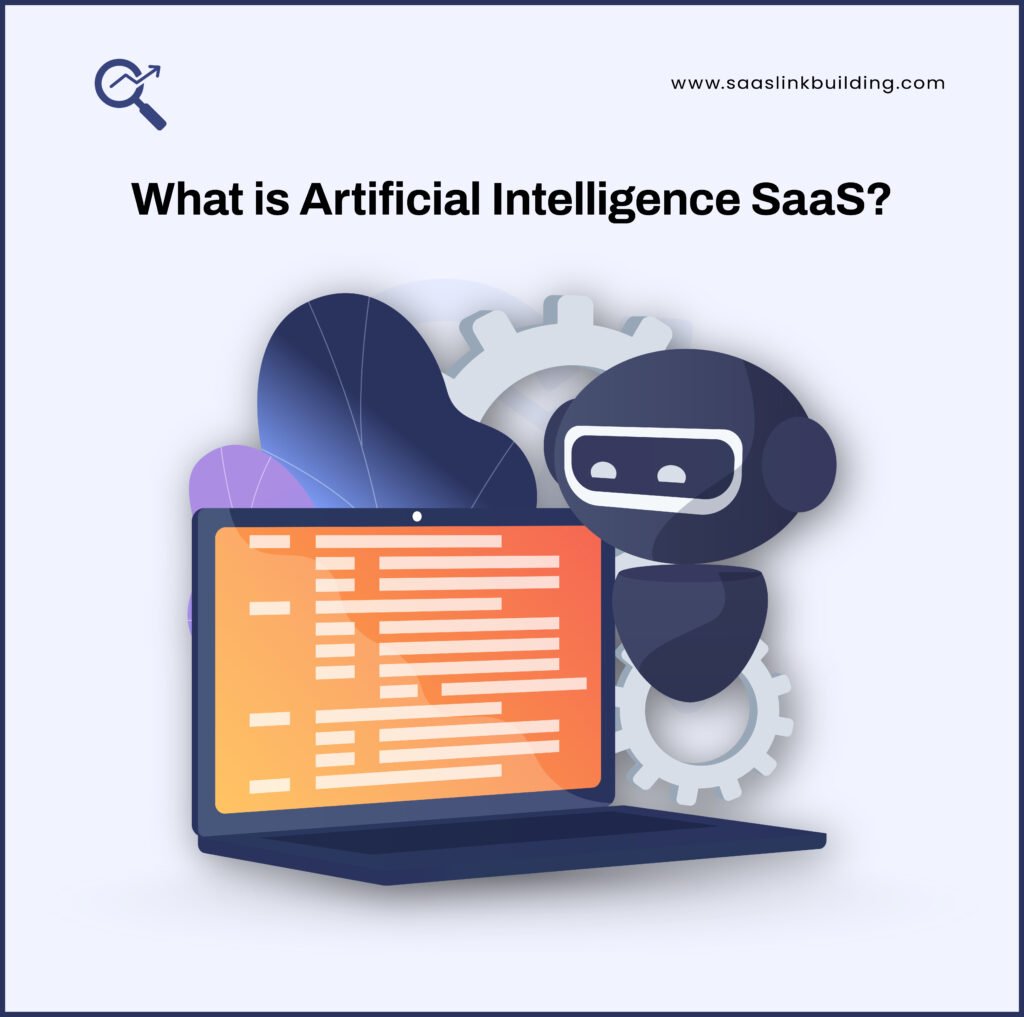
AI SaaS, or Artificial Intelligence Software as a Service, is cloud-based software that uses advanced AI technologies—like machine learning, natural language processing, and computer vision—to deliver smart, automated solutions over the internet.
In short: It’s smart software, delivered on-demand, with zero hassle and maximum impact.
Unlike traditional software that just runs tasks, AI SaaS tools learn from data, get better over time, and help businesses make faster, more accurate decisions—without needing a team of data scientists.
Key Components of AI SaaS
So what powers these tools? Here are the core elements that make AI SaaS so powerful:
- Machine Learning (ML): Teaches software to learn from patterns in data and improve performance automatically.
- Natural Language Processing (NLP): Enables tools to understand, interpret, and respond to human language—perfect for chatbots, voice assistants, and support systems.
- Computer Vision: Helps software “see” and analyze images or video—useful in sectors like retail, manufacturing, and healthcare.
- Cloud Infrastructure: Everything runs on secure, scalable cloud servers, so there’s no need for on-site hardware or maintenance.
These technologies work together to deliver intelligent, scalable, and user-friendly experiences through the cloud.
Why Businesses Love AI SaaS?
We all want tools that work smarter, not harder. That’s exactly what AI SaaS brings to the table:
- Scalability: Add more users or features as you grow—no need for complex setups or IT headaches.
- Cost-Effectiveness: Pay-as-you-go models mean zero upfront costs and no surprise maintenance bills.
- Accessibility: Access your tools from anywhere, anytime—whether you’re on a laptop in the office or checking in from your phone on the go.
- Continuous Learning: These tools evolve with your business. The more data they get, the smarter they become.
AI SaaS is no longer a luxury for big enterprises—it’s now a competitive advantage for startups, mid-sized businesses, and even freelancers. If you’re still relying on outdated tools or manual workflows, you could be falling behind.
Real-World Applications of AI SaaS
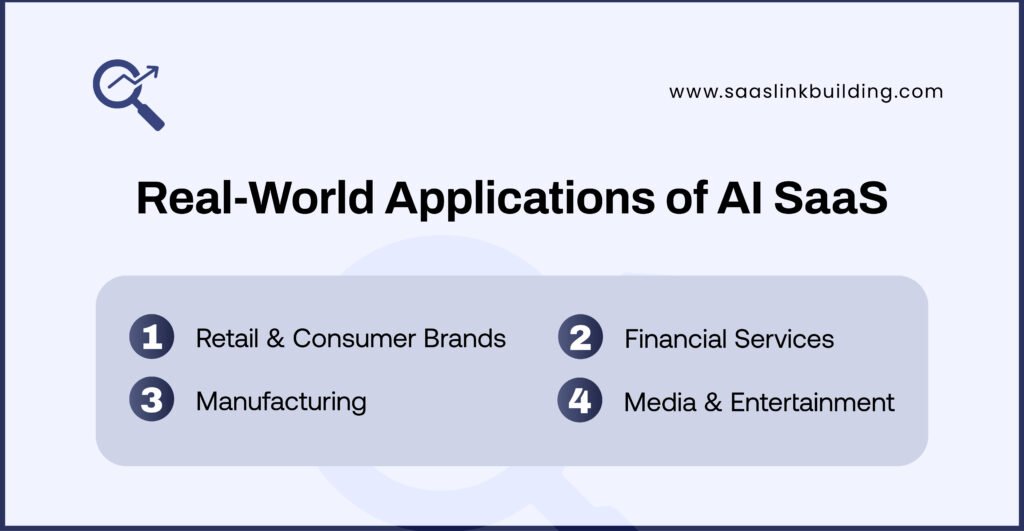
Alright, let’s get practical. We’ve talked about what AI SaaS is and how it works—but where is it actually being used?
The answer: Everywhere.
From retail shops to banks, factories to media companies—AI-powered SaaS tools are quietly making work faster, smarter, and more efficient.
Here’s how different industries are using AI SaaS in real life:
1. Retail & Consumer Brands
If you’ve ever wondered how online stores seem to “know” what you want—yep, that’s AI SaaS in action.
- Better Forecasting: Stores can predict what people will buy and stock up accordingly.
- Smarter Recommendations: AI suggests products based on your browsing and buying habits.
- Improved Support: Chatbots answer questions instantly, day or night.
- Why it matters: Retailers save money, avoid overstocking, and make shopping feel more personal.
2. Financial Services
Banks and fintech companies love AI SaaS because it helps them move fast—while staying secure.
- Spotting Fraud Fast: AI can detect weird or risky transactions in real-time.
- Smarter Lending Decisions: It helps evaluate who’s a good fit for loans, using data—not just credit scores.
- Why it matters: It’s safer for customers and faster for businesses.
3. Manufacturing
In factories, downtime can be expensive. AI SaaS helps keep things running smoothly.
- Fix Before It Breaks: AI watches machines and predicts when something’s about to go wrong.
- Optimize Production: It shows where work slows down and how to speed things up.
- Why it matters: Fewer breakdowns, more products, and lower costs.
4. Media & Entertainment
Ever wondered how your favorite platform seems to recommend the perfect video or article? AI is behind that too.
- Smarter Content: AI analyzes what people enjoy most—and helps create or promote similar content.
- Audience Insights: Media teams learn what keeps people watching or reading.
- Why it matters: More engagement, better ads, and higher revenue.
AI SaaS is already everywhere—quietly working behind the scenes to improve how businesses serve their customers and manage operations. And it’s not just for big companies anymore. Small and mid-sized businesses are using these tools too—because they’re affordable, powerful, and easy to use.
Case Studies: Real Companies Using AI SaaS
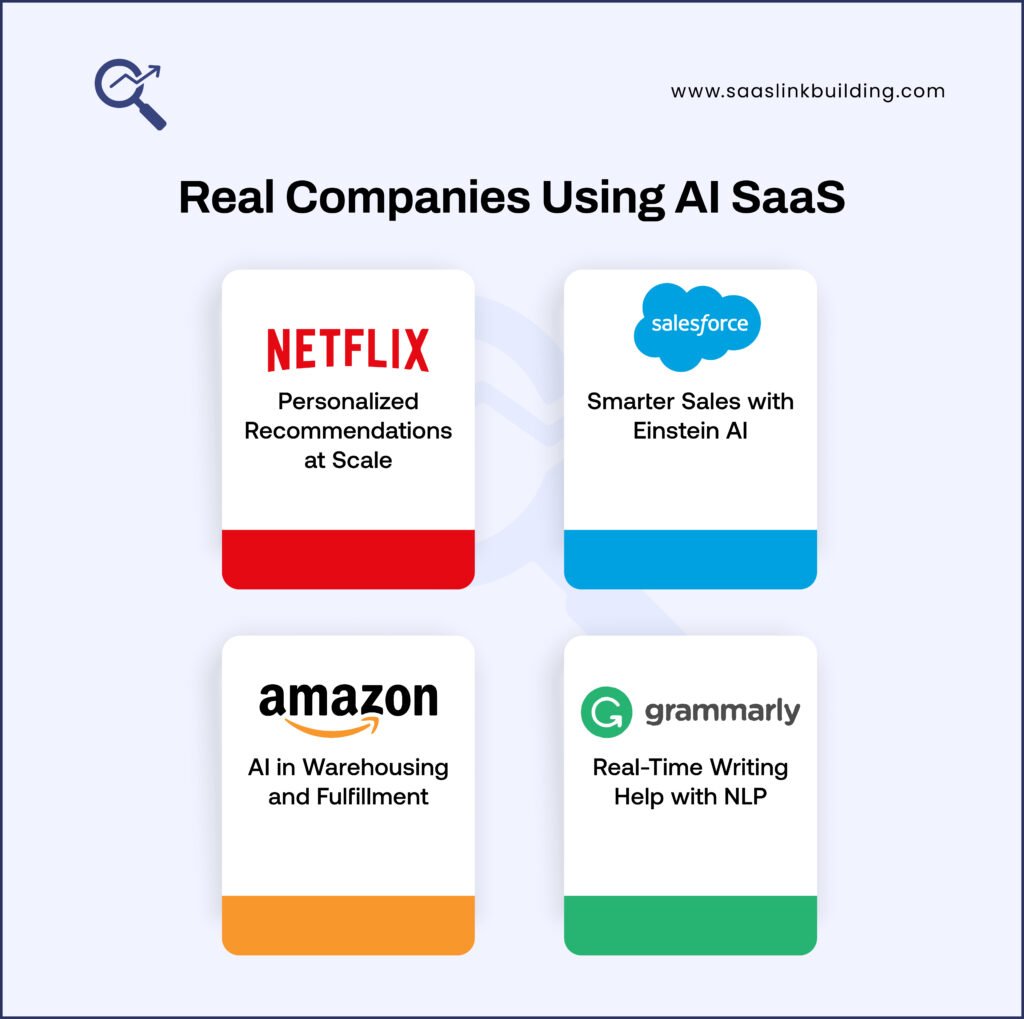
Let’s move beyond theory. You’ve seen how AI SaaS works across industries—but what does it look like in the real world?
Here are a few real examples of companies that are using AI SaaS solutions to solve problems, save time, and grow faster. These stories prove that smart software isn’t just a nice-to-have—it’s a game changer.
1. Netflix – Personalized Recommendations at Scale
You know how Netflix always seems to know what show you’ll like next? That’s not a lucky guess—it’s AI SaaS at work.
- What they use: Netflix uses AI-powered recommendation engines delivered via SaaS platforms.
- How it helps: It analyzes your viewing habits, compares them with millions of other users, and serves up personalized suggestions.
- Why it matters: Over 80% of what people watch on Netflix comes from these AI suggestions.
Takeaway: Netflix keeps viewers engaged longer—and cuts down on search fatigue.
2. Salesforce – Smarter Sales with Einstein AI
Salesforce added a powerful AI layer called Einstein into its CRM as a SaaS solution.
- What it does: It scores leads, predicts customer behavior, and automates follow-ups.
- The benefit: Sales teams spend less time guessing and more time closing deals.
- Takeaway: With AI SaaS built right into the CRM, teams make faster, smarter sales decisions.
3. Amazon – AI in Warehousing and Fulfillment
Amazon isn’t just an e-commerce giant—it’s a leader in using AI-powered SaaS for logistics and supply chain management.
- What they use: AI tools predict product demand, manage inventory, and route orders efficiently
- Results: Faster deliveries, lower costs, and better customer satisfaction.
- Takeaway: AI SaaS helps Amazon manage millions of daily orders without slowing down.
4. Grammarly – Real-Time Writing Help with NLP
Grammarly is a classic AI SaaS product that millions of people use every day.
- What it does: Uses natural language processing (NLP) to analyze your writing, fix grammar, and suggest improvements.
- Why it works: It’s cloud-based, learns over time, and works across devices.
- Takeaway: Grammarly shows how even individuals can benefit from powerful AI tools—no tech team needed.
These case studies prove one thing: AI SaaS works—and it’s working now. Whether you’re running a global company or a solo business, AI SaaS can help you save time, make smarter choices, and compete with the big players.
Key AI Technologies Powering SaaS Today
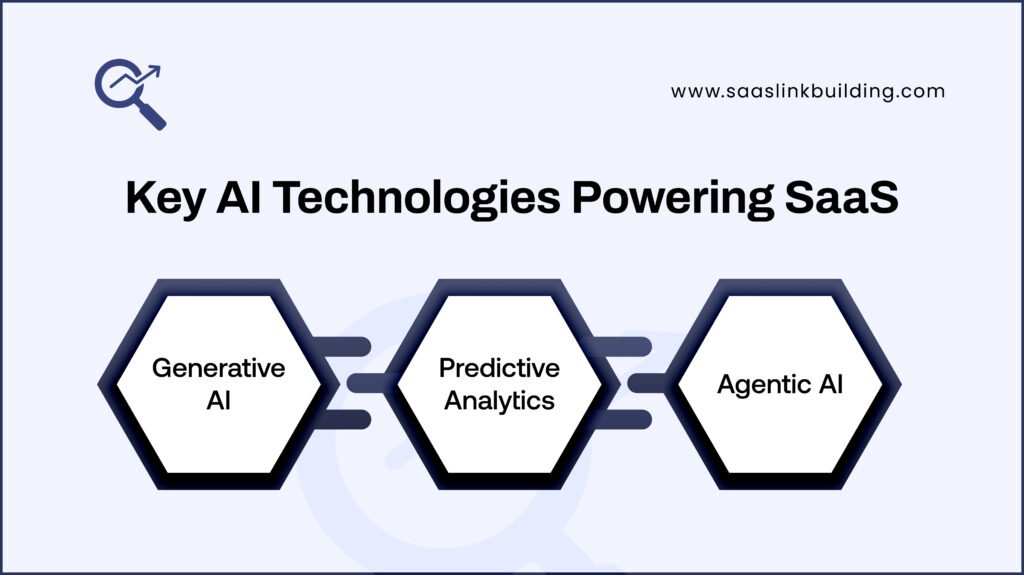
So, what actually makes AI SaaS tools intelligent?
It’s not magic—it’s a mix of powerful technologies working together in the background. These tools are what give AI SaaS the ability to learn, create, predict, and even make decisions on its own.
Let’s break down the three key technologies that are transforming how software works for us.
1. Generative AI – Creating Content, Ideas, and More
Generative AI is the tech behind tools that create—whether it’s text, images, code, or even product ideas.
Think of ChatGPT or tools like Jasper and Canva’s AI design feature.
They generate blog posts, marketing copy, emails, social posts, images, and more—in seconds.
Why it matters:
Businesses save time and money by automating content creation, boosting productivity without sacrificing quality.
Example use case: A marketing team can create an entire email campaign using just a prompt and an AI writing tool—no copywriter required.
2. Predictive Analytics – Seeing the Future (Almost)
Predictive analytics helps businesses forecast what’s coming by analyzing past data.
It spots trends, customer behaviors, and possible risks before they happen.
Popular in industries like eCommerce, finance, and healthcare.
Why it matters:
Instead of guessing, you can make decisions based on real data. Want to know what product might go out of stock next month? Predictive AI can tell you.
Example use case: Retailers use predictive analytics to manage inventory and plan promotions more effectively.
3. Agentic AI – Making Decisions on Its Own
Agentic AI goes a step further—it doesn’t just give suggestions, it takes action.
It can manage tasks, send emails, or adjust prices—all without human input.
Often used in automation platforms and AI agents like AutoGPT or personal AI assistants.
Why it matters:
It reduces manual work and speeds things up. Businesses can run smarter operations with less day-to-day management.
Example use case: A SaaS tool could automatically shift your ad budget based on performance—no need to log in and adjust things manually.
In Short: These AI technologies—Generative AI, Predictive Analytics, and Agentic AI—are the brains behind modern SaaS tools. They’re what make software smarter, faster, and more helpful than ever before.
And the best part?
You don’t need to be a tech wizard to use them. Most AI SaaS platforms are designed to be user-friendly—even if you’ve never touched code in your life.
Challenges and Considerations Before Using AI SaaS
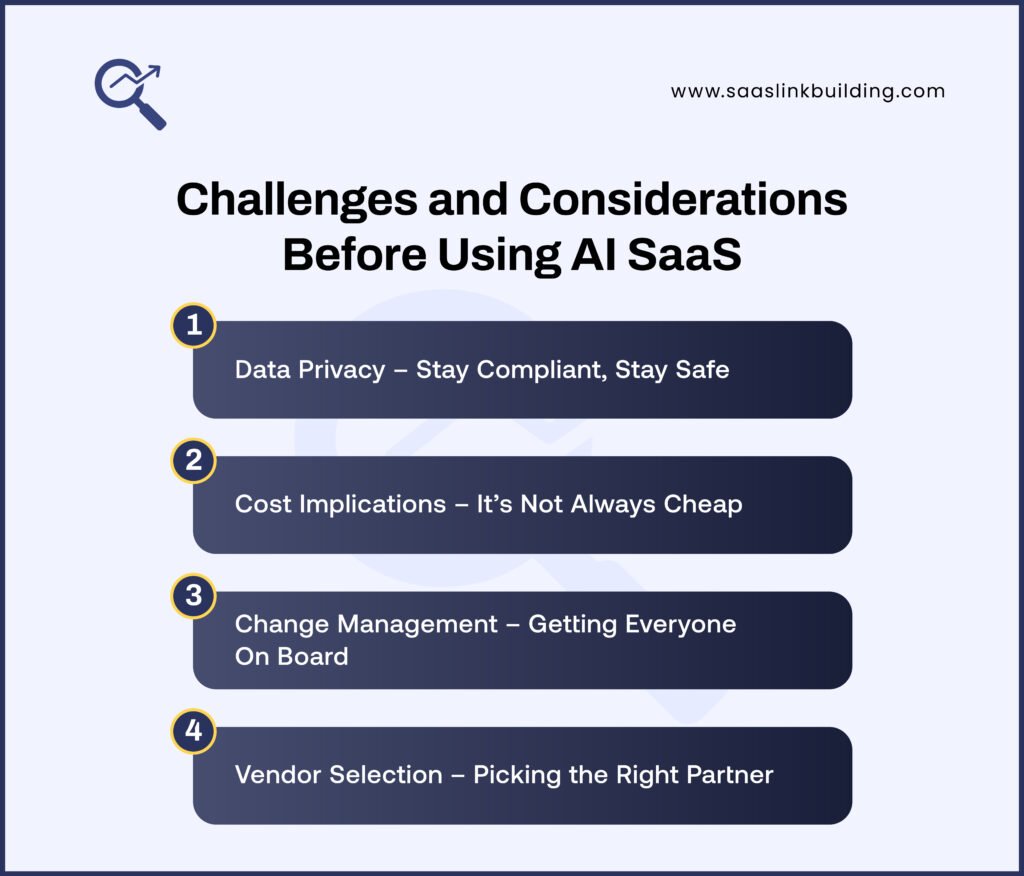
Let’s be honest—AI SaaS offers a ton of benefits, but it’s not without its challenges. Before you dive in, it’s important to know what to watch out for. The good news? If you’re aware of the risks early on, you can avoid most of the common mistakes businesses make.
Here are the key things you should think about before adopting any AI SaaS tool:
1. Data Privacy – Stay Compliant, Stay Safe
When you’re using AI tools, you’re likely working with customer data. And that means you need to be extra careful.
Compliance Matters: You’ll need to follow data protection laws like GDPR, CCPA, or India’s DPDP Bill.
Secure Storage: Make sure the SaaS provider uses encryption and follows industry-standard security practices.
Data Ownership: Always read the fine print—know who owns the data and how it’s being used.
Tip: Choose AI SaaS platforms that are transparent about their privacy policies and offer compliance features built-in.
2. Cost Implications – It’s Not Always Cheap
AI SaaS is often more affordable than building your own AI systems—but it’s still an investment.
Monthly or usage-based pricing can add up.
Some features (like advanced analytics or automation) may cost extra.
Training your team or integrating the tool can take time and money too.
Tip: Start with a free trial or a smaller plan. Scale up only if it adds real value.
3. Change Management – Getting Everyone On Board
Even the best tech can fail if your team isn’t ready to use it.
New Tools = New Habits: Teams may need time (and training) to adapt.
Resistance to Change: Some people might hesitate to trust AI, especially when it replaces manual tasks.
Internal Communication is Key: Explain the benefits, provide support, and celebrate quick wins.
Tip: Choose user-friendly platforms and make sure your people understand how it helps them—not just the business.
4. Vendor Selection – Picking the Right Partner
All AI SaaS tools are not created equal. Choosing the wrong one can waste both time and money.
When choosing a vendor, consider:
- Data Security Standards
- Ease of Use
- Scalability
- Support and Training
- Customer Reviews and Case Studies
Helpful Tip: Check platforms like G2 or Capterra to compare vendors before making a decision.
AI SaaS can be powerful—but only if you use it wisely.
By thinking ahead about things like privacy, pricing, people, and partners, you’ll be in a much better position to get the most out of your investment
Future Outlook: Where Is AI SaaS Headed Next?
AI SaaS is moving fast—and it’s only just getting started.
We’ve already seen how businesses are using AI to save time, cut costs, and make smarter decisions. But what’s next? What will AI SaaS look like in the coming years?
Let’s explore some key trends and predictions that show where things are headed.
Emerging Trends in AI SaaS
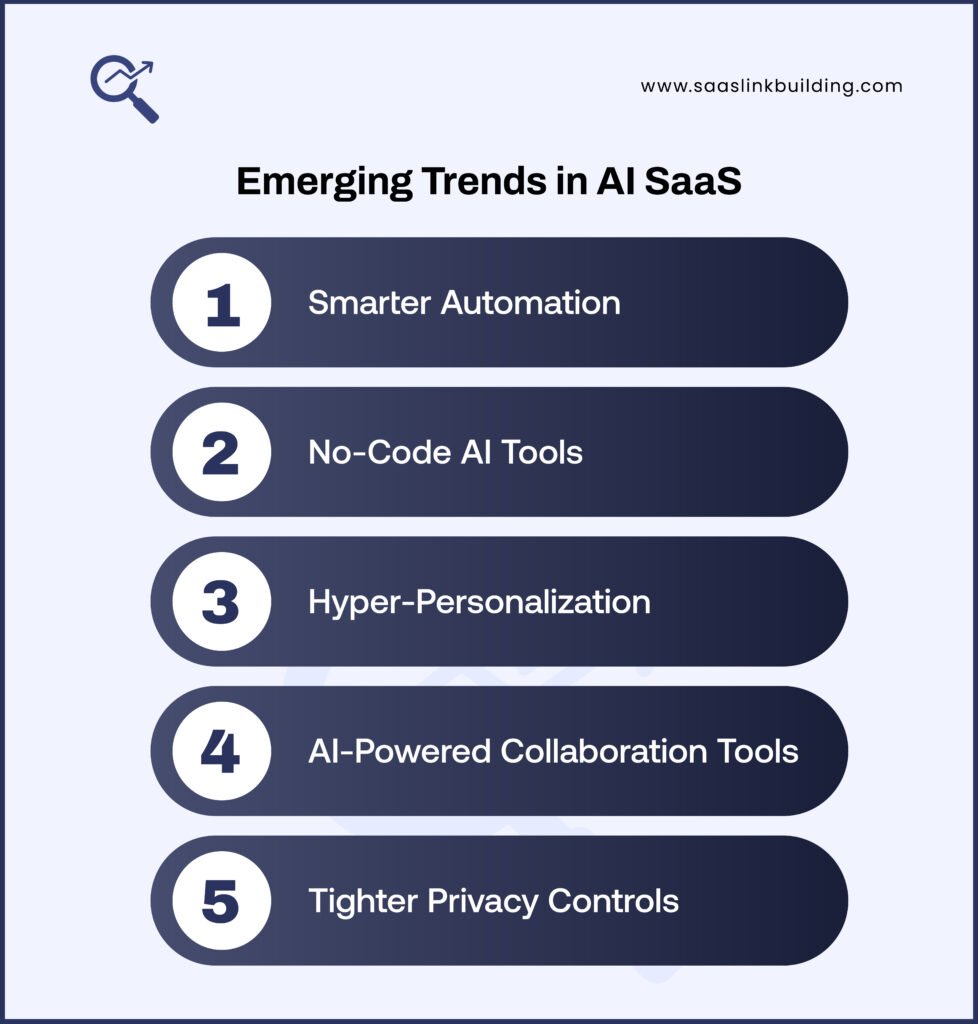
Here are some exciting developments already shaping the future of AI-powered software:
- Smarter Automation: AI tools will get better at handling complex tasks—like managing workflows, writing content, or making business decisions—without constant human input.
- No-Code AI Tools: You won’t need to be a developer to build and use advanced AI. Drag-and-drop platforms and no-code builders are making AI accessible for everyone.
- Hyper-Personalization: From marketing to customer service, AI SaaS tools will deliver more personalized experiences, tailored to individual users in real time.
- AI-Powered Collaboration Tools: Expect smarter meetings, auto-generated summaries, and intelligent task tracking built right into your team software.
- Tighter Privacy Controls: With more regulations coming in, AI SaaS companies will double down on privacy and transparency.
What Experts Predict for the Next 5–10 Years
Let’s keep it simple: AI SaaS is going to become a core part of every business, big or small.
- AI will be everywhere: From hiring and HR to inventory and customer support, AI tools will become as common as email.
- Smaller businesses will gain power: Thanks to affordable AI SaaS tools, startups and solo entrepreneurs can compete with enterprise-level players.
- AI assistants will become standard: Tools like ChatGPT, Claude, or AI co-pilots will be built into most apps—helping you write, analyze, plan, or even make decisions.
- Industry-specific AI SaaS will grow fast: We’ll see more tailored tools for healthcare, education, logistics, and more—built to solve very specific problems.
Want to Market Your AI SaaS Product Better?
AI SaaS tools are powerful—but even the smartest solutions need smart marketing. If you’re building or scaling an AI SaaS business, having the right SaaS marketing strategy can make all the difference. From boosting visibility and building trust to driving qualified traffic, a well-planned marketing approach helps you stand out in a competitive space.
👉 Explore our complete SaaS marketing guide to learn how to grow your AI SaaS product faster and more effectively.
Conclusion: Why AI SaaS Isn’t Just the Future—It’s the Now
Let’s be real—AI SaaS isn’t just a trend. It’s quickly becoming a core part of how smart businesses operate every day.
From automating tasks and predicting customer behavior to creating content and making real-time decisions, AI-powered SaaS tools are changing the game. And the best part? You don’t need a massive budget or a team of engineers to take advantage of it. Most tools today are built for speed, simplicity, and scalability.
Here’s what to remember:
- Start small, but start smart. Test tools that solve real problems in your business.
- Focus on people first. Make sure your team understands how AI helps—not replaces—them.
- Pick the right tools. Choose trusted, secure, and transparent vendors.
- Stay curious. AI evolves fast, so keep learning and experimenting.
Whether you’re running a solo business, scaling a startup, or leading a large team, AI SaaS gives you the power to do more—with less effort, less cost, and way more speed.
So if you’ve been waiting to explore AI in your business, now’s the time. The tools are ready. The benefits are real. And the future? It’s already here.

